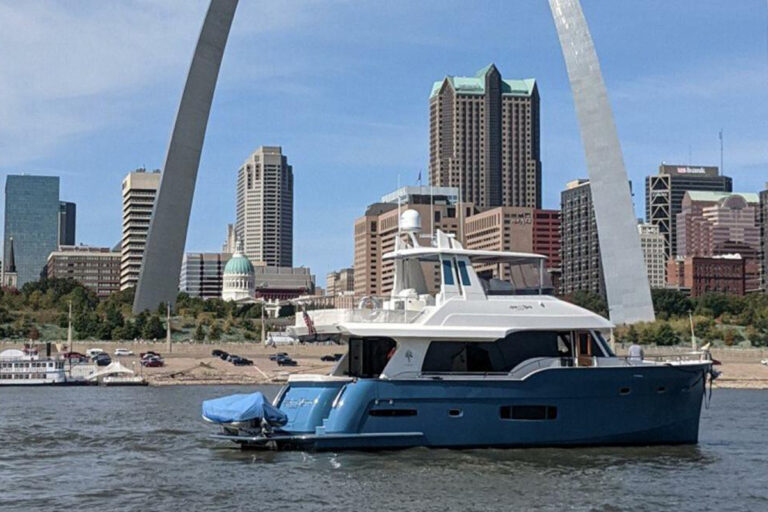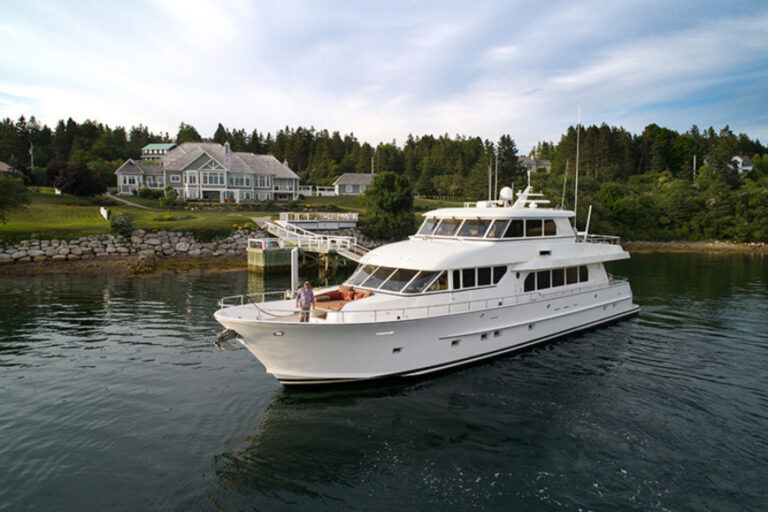Don’t let the simplicity of this lovely lobster skiff fool you. Drawing a 25′ boat of such beauty requires an artist’s touch, and if her way through the water is to equal the quality of her looks, the designer had better know his stuff.
Jesse Lowell does. He is a son of Carroll Lowell, a master at designing and building honest-to-God Maine lobster boats. Jesse practices his craft at Lowell Boatworks. I stumbled across his booth in a corner of the exhibition shed at the Maine Boatbuilder’s Show this past March. He’d spread drawings on the table and had the full-size skeleton of the 25 resting on a strongback to the left. The boat’s profile interrupted my breathing and awakened the fiscally irresponsible demon in me.
Although Lowell designed this open lobster boat as a pleasure launch, her gene pool is pure work boat. Her graceful sheerline does more than make us swoon when we look at it. This proud bow gives the boat great seakeeping ability for her size, and the low freeboard right abaft amidships would let a working lobsterman haul traps over the side without busting a gut. We could argue that the sheerline’s rise on its approach to the transom prevents following seas from dumping into the cockpit, and we’d probably be right. I think Lowell drew it as much for its beauty.
He definitely considered looks when he included the cockpit coaming around the stern sheets. Stern sheets, by the way, is an old-time term for wraparound seating way back aft. Yes, it’s always plural. I’m sure the designer would be willing to admit that this coaming provides more support for the passengers’ backs, but he’d also agree that they could live without it.
Standing at the helm is the customary way to con a lobster skiff, so I’d want a removable seat at the helm. As drawn, the seat is too close to the wheel to let the helmsman stand without straddling the seat. The engine box right forward of the helm could double as seating or a dining table set up with wood-frame/canvas folding chairs. I’d be inclined to specify fold-down leaves to expand the surface area. The folks in the bow seats could have a little folding table to themselves, one that you would stow in chocks on the forward bulkhead. “Open the champagne, dear, lunch is served.”
This 25 has the same proportions that proved so successful for Jesse’s father. Her beam is a third of her datum waterline length, which gives the soft-chine hull adequate initial stability but doesn’t force her to use a lot of horsepower to maintain a comfortable cruising speed. I bet she’ll be happy with a 50 hp diesel, if you don’t plan on a heavy payload. She’ll cruise all day long at 12 knots, sipping fuel instead of gulping. She’ll likely scoot right along if you increase the power by a half, or double it. A beamier boat wouldn’t be as pretty or travel through the water with such ease. Jesse’s father always regretted the growing beam lobstermen demanded so they could carry more traps. To his way of thinking, the increase spoiled the boats’ running characteristics. Jesse seems to have absorbed the same sensibilities.
Traditional wood construction scares a lot of yachtsmen, but this design begs for it. I’d certainly choose wood, because modern finishes have taken most of the grief out of owning a wooden boat. Lowell, on the other hand, is a 21st-century man as well as a traditionalist, so you’ll have no trouble getting him to build the 25 in fiberglass. Wood trim, like a model’s makeup, will fool the casual observer into thinking he’s looking at a plank-on-frame boat. Whichever material you choose for your lobster skiff, you’ll have a genuine Down East launch. Think of how the deck of your mothership will look with one of these gems in the chocks.
Contact: Lowell Boatworks, (207) 353-8010.









